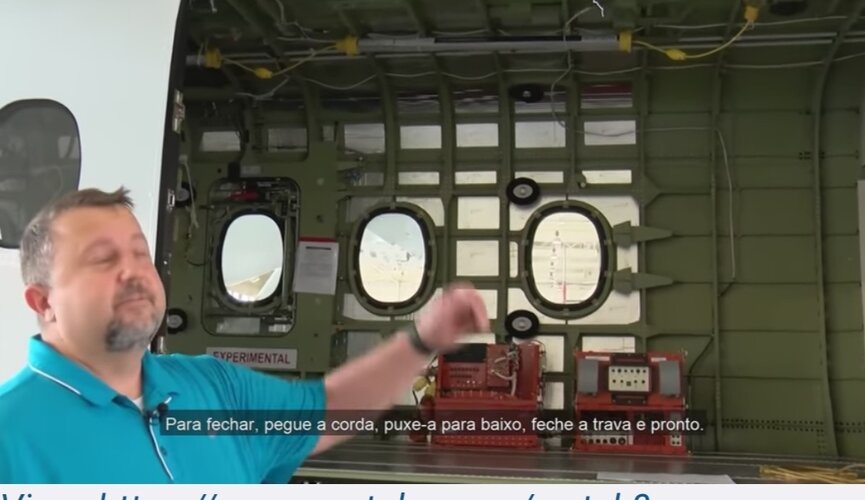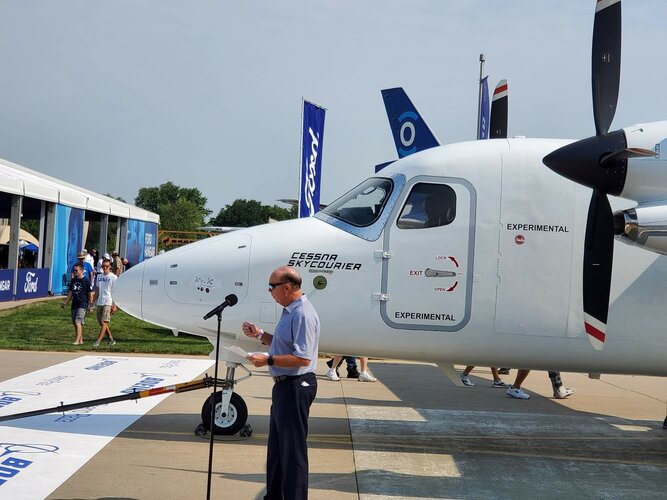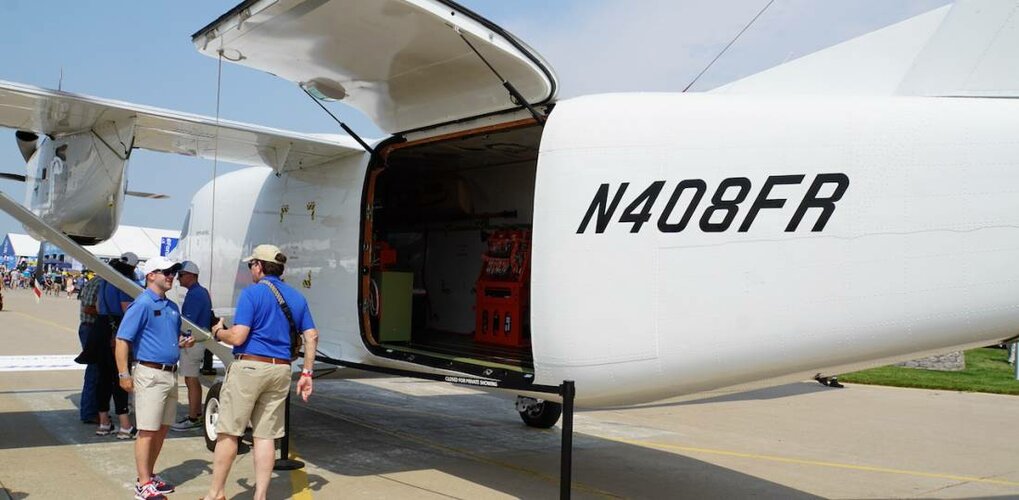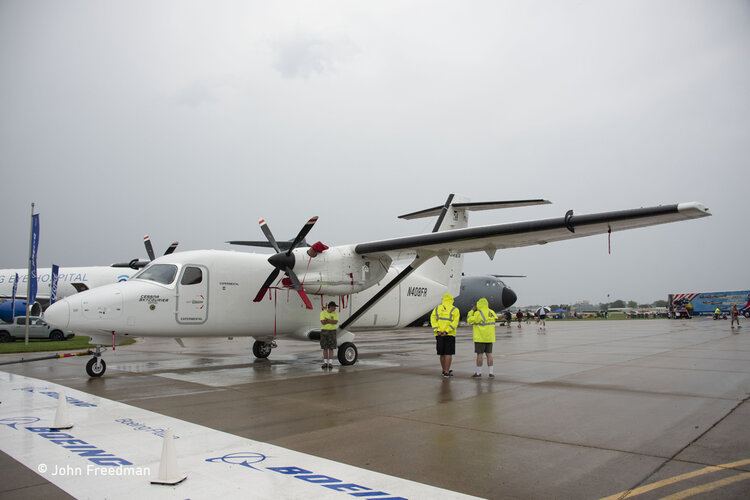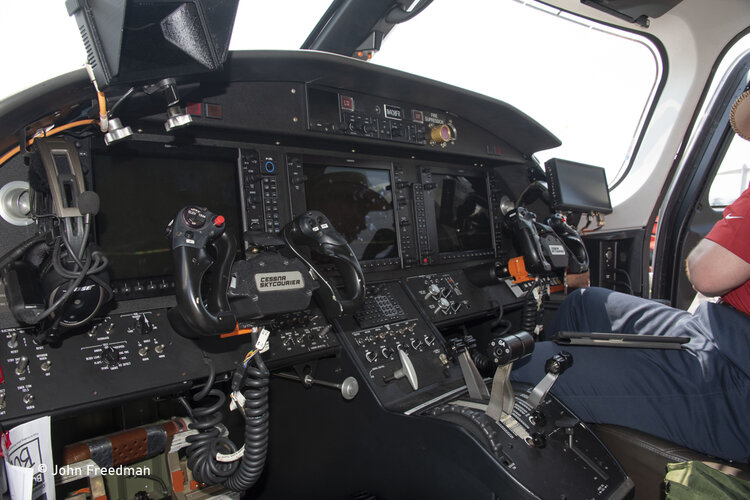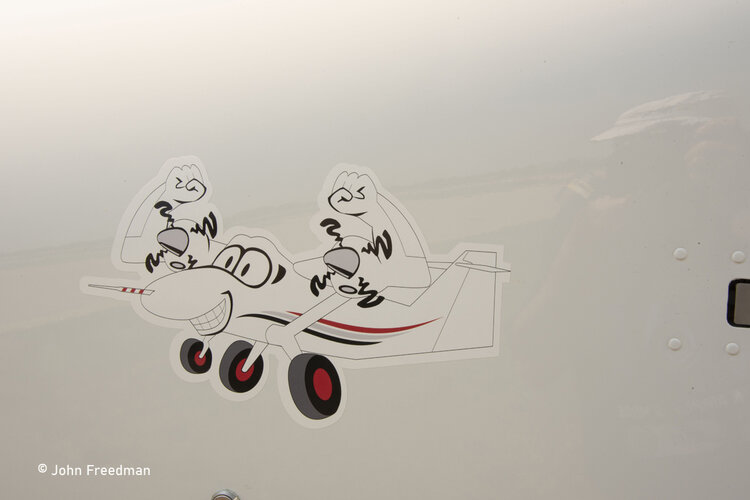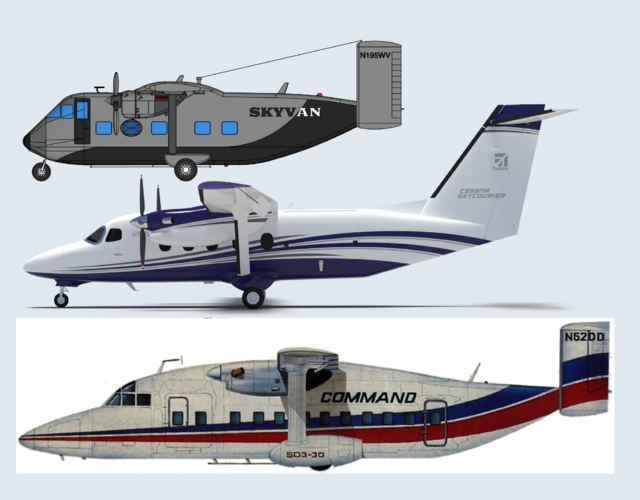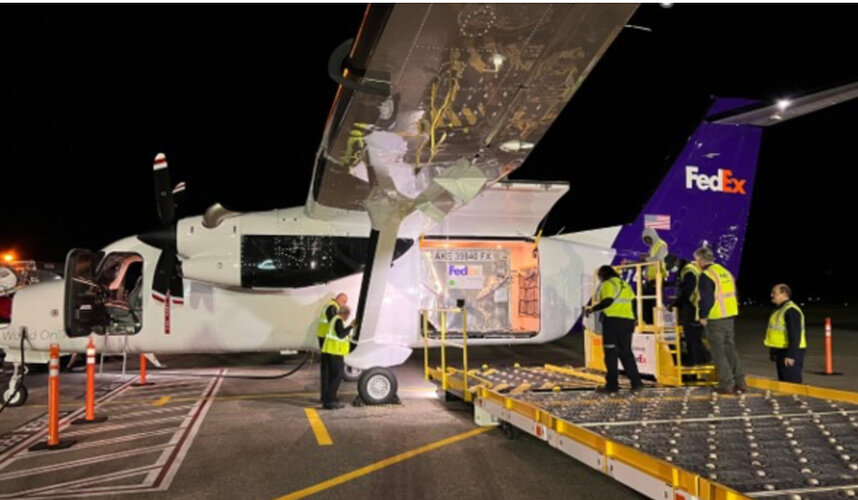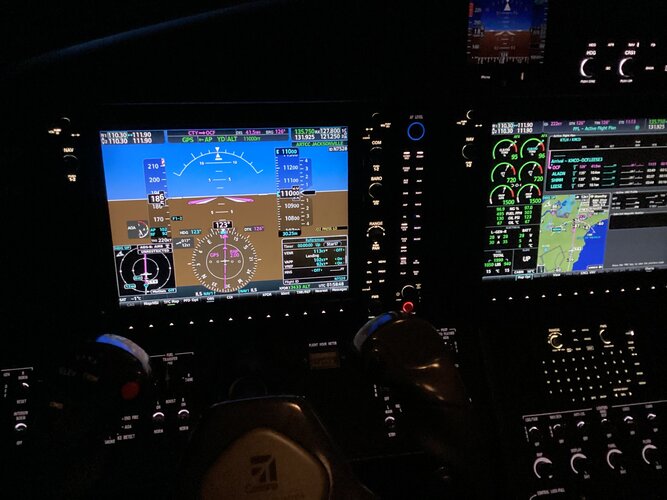The question boils down to whether you can make a business case for this capability (19 pass/3 LD3-6000lb cargo) for $5.5M. For an island transport, you could charge $50/flight for 300 passengers/day and recover the planes cost in 1 year (minus pilot salary). I assume the maintenance costs for a plane like this will be fairly low. Just a reminder from post 64.
You are using an out of date browser. It may not display this or other websites correctly.
You should upgrade or use an alternative browser.
You should upgrade or use an alternative browser.
Cessna 408 SkyCourier
- Thread starter Hood
- Start date
- Joined
- 16 April 2008
- Messages
- 9,608
- Reaction score
- 14,506
That's almost 20 departures a day at 80% load factors (15-16 pax average), which seems a tad optimistic. It also ignores all the other costs around a flight (airport fees, flight attendant, ticketing/ground staff, baggage handling, etc.)
That's to recover the airplane cost in 1 year. In practice, I assume the amount is pegged to "positive cash flow" which is probably too messy to figure since it includes taxes, government subsidies (eg, low serviced populations), and the like.
- Joined
- 16 April 2008
- Messages
- 9,608
- Reaction score
- 14,506
That's to recover the airplane cost in 1 year. In practice, I assume the amount is pegged to "positive cash flow" which is probably too messy to figure since it includes taxes, government subsidies (eg, low serviced populations), and the like.
fredymac, sorry, I should have thanked you for this earlier. I misunderstood what you were trying to say. Indeed, this does look like it might be economical for those sorts of flights.
Last edited:
- Joined
- 18 October 2006
- Messages
- 4,211
- Reaction score
- 4,921
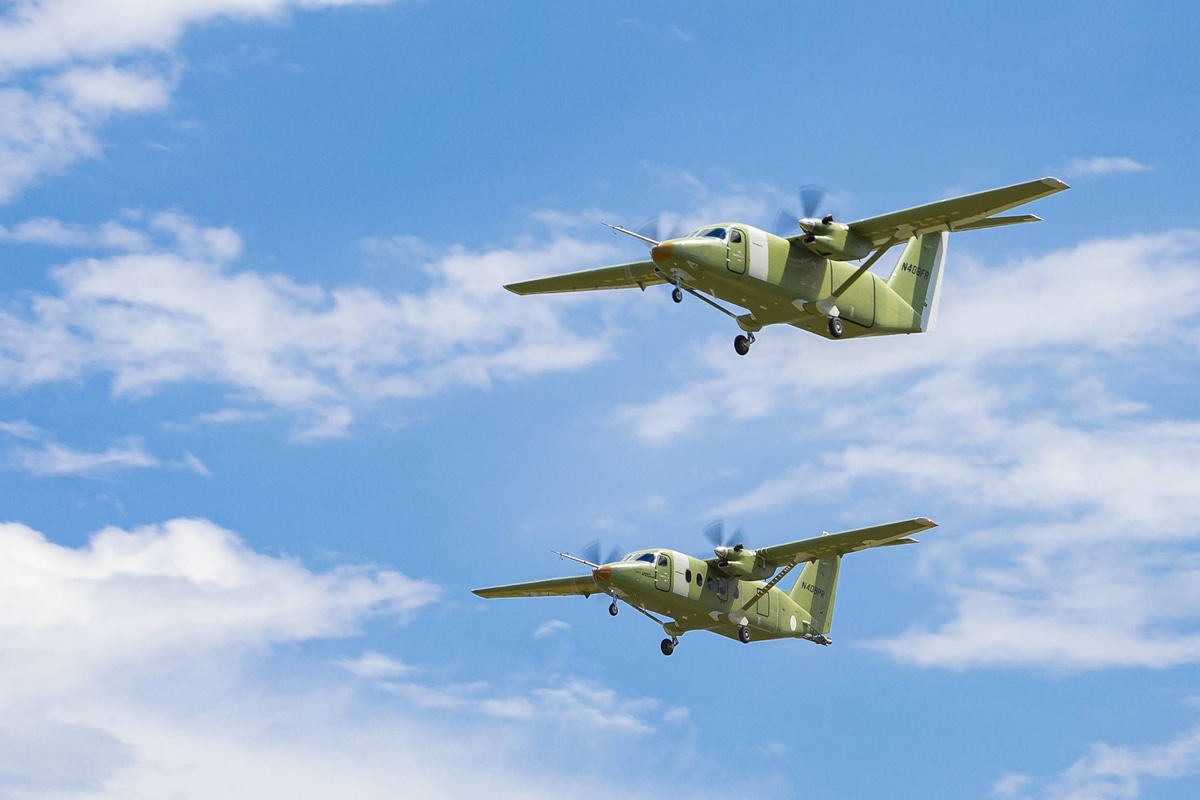
Second Cessna SkyCourier Completes First Flight | AIN
The first conforming production flight test Cessna SkyCourier flew for one hour 35 minutes on its inaugural flight.
Textron must have had a quiet purge at senior levels as the Textron aerospace sector has really turned up the wick in the last couple of years, both Cessna and Bell.
3rd prototype (P2) first flight:
https://txtav.com/en/newsroom/2020/...urier-test-aircraft-joins-flight-test-programWICHITA, Kan. (Sept. 29, 2020) – The Cessna SkyCourier turboprop development program has achieved another significant milestone as the third and final flight test aircraft (P2) successfully completed its first flight on Monday, Sept. 28, 2020. This maiden flight for the high-wing, large utility aircraft comes on the heels of the second test article (P1) completing its initial flight in August 2020. The P2 aircraft is the second airframe configured in the passenger variant, and it will join two other aircraft in the flight test certification program, which to date have already accumulated 150 flight hours.
[...]
The first flight of P2, piloted by Todd Dafton and Caleb Quick, lasted 90 minutes, reaching a speed of 210 ktas and an altitude of 15,000 feet. The aircraft will primarily be used to focus on avionics testing, flammable fluids testing, and the cold and hot weather testing in the climatic chamber at Eglin Air Force Base.
alberchico
I really should change my personal text
- Joined
- 14 January 2014
- Messages
- 708
- Reaction score
- 1,514
This sales presentation video gives an overview of the aircraft as well as a good glimpse of the cockpit. I'm surprised Cessna has not released an official picture of the flight deck.
- Joined
- 16 April 2008
- Messages
- 9,608
- Reaction score
- 14,506
Notice how he noticed that the chord was too short for him to catch it and demo how easily it is to close the cargo door
View attachment 658528
(The chord is the little white thread that you see on top of the picture)
Yeah, I noticed that too. Slightly embarrassing and something I'd have fixed rather than publishing as is. Only feel like that cord needs a knob or handle to grab as well.
Silencer1
That now I am the Ruler of the Queen's Navee!
- Joined
- 3 August 2009
- Messages
- 897
- Reaction score
- 582
Interesting video, thanks for sharing! I wonder, however, why it placed on Youtube page of certain "TAM Aviação Executiva", rather then Cessna or Textron?
Yeah, I noticed that too. Slightly embarrassing and something I'd have fixed rather than publishing as is. Only feel like that cord needs a knob or handle to grab as well.Interesting video!
Note about chord is important, as the Cessna' representative later talks, how sophisticated is new design of forward door, which could fix it in open position and resists to strong winds.
Just imagine, how these winds could "wave" the chord of main door, completely preventing catching it from the ground level.
Or if the loaded container captivate it on it's roof.
P.S. perhaps "Nike" pays a big money for the product placement of their polo in this movie
Last edited:
- Joined
- 16 April 2008
- Messages
- 9,608
- Reaction score
- 14,506
I wonder, however, why it placed on Youtube page of certain "TAM Aviação Executiva", rather then Cessna or Textron?
TAM Aviação Executiva is the agent for Textron in Brazil. Hence the subtitles.
Textron Aviation rolled out the first production Cessna 408 SkyCourier for launch customer FedEx, the Wichita-based airframer announced today. This comes as the SkyCourier program's three test aircraft have logged more than 2,100 flight hours. FAA certification of the utility twin-turboprop is expected in the first half—approximately two years after the SkyCourier's first flight in May 2020.
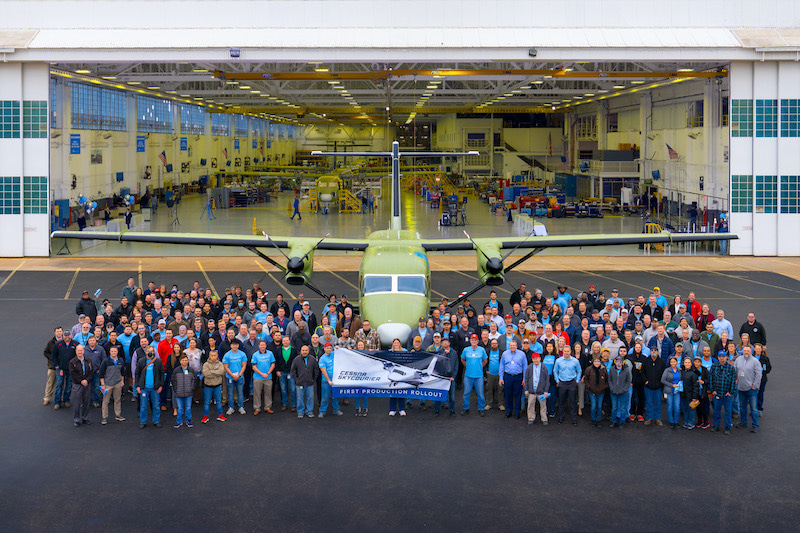
Textron Aviation Rolls Out First Production SkyCourier | AIN
The first production Cessna 408 SkyCourier is destined for launch customer FedEx.
alberchico
I really should change my personal text
- Joined
- 14 January 2014
- Messages
- 708
- Reaction score
- 1,514
Some images of one of the prototypes, including the cockpit. Funny how they have a sticker on the fuselage of their arch rival.  You would think that Cessna with all their resources would have commissioned some custom stickers by now. Considering that Cessna can sell this at a lower price than the Viking Otter, and the fact that it can carry a heavier payload, means that it should be popular with smaller carriers, especially those that already operate the Caravan. Cessna will generate even more sales if they get around to developing a float plane version. However the Otter does have the advantage of being a very rugged aircraft with extreme STOL capabilities making it the only aircraft suitable for certain missions. It will be interesting to see the market for this aircraft in the next few years.
You would think that Cessna with all their resources would have commissioned some custom stickers by now. Considering that Cessna can sell this at a lower price than the Viking Otter, and the fact that it can carry a heavier payload, means that it should be popular with smaller carriers, especially those that already operate the Caravan. Cessna will generate even more sales if they get around to developing a float plane version. However the Otter does have the advantage of being a very rugged aircraft with extreme STOL capabilities making it the only aircraft suitable for certain missions. It will be interesting to see the market for this aircraft in the next few years.
Attachments
Last edited:
- Joined
- 11 March 2012
- Messages
- 3,250
- Reaction score
- 3,179
Over on www.dropzone.com, some one posted that the cargo door is a structural member and cannot be opened in flight.
Can any one confirm this rumor?
Can any one confirm this rumor?
alberchico
I really should change my personal text
- Joined
- 14 January 2014
- Messages
- 708
- Reaction score
- 1,514
Over on www.dropzone.com, some one posted that the cargo door is a structural member and cannot be opened in flight.
Can any one confirm this rumor?
Since the design was closely tailored to the needs of FedEx, which is to accommodate large containers, it probably won't be suitable for skydiving. This document shows that the passenger version will retain the large door.
However the govt has added this aircraft to its FMS program, in order to facilitate military sales with allies abroad. It is possible Cessna could develop a version with a modified door that would allow parachute operations. It's also a possibility that the U.S. miitary themselves could acquire this aircraft down the line. But don't skydiving operations usually buy cheap secondhand aircraft ? This bird might be too expensive for them right now.
A great potential market for this aircraft, for both civil and military sales would be Indonesia, but they already have their very own 19 seater, the N-219, ready to enter service. Another huge market is Canada, but as long as the Viking Otter remains in production i don't think they'll have much luck there. China could be a big market but they also have their very own 19 seater, called the Y-12F, that just went into service that also carries large freight containers. They also seem to prefer the Otter.
US to provide C408 SkyCourier to FMS customers
The US Department of Defense (DoD) is to provide the Cessna C408 SkyCourier twin-turboprop to Foreign Military Sale (FMS) customers as part of a wider light transport...
www.janes.com
Last edited:
- Joined
- 18 October 2006
- Messages
- 4,211
- Reaction score
- 4,921
I suspect that there is another version, at least designed, to allow for air operations. To large a market to be ignored. Launch customer wanted the big door for the most economical loading/unloading, so that is what we will see till another customer requires a different door.
- Joined
- 11 March 2012
- Messages
- 3,250
- Reaction score
- 3,179
Granted, the cargo door on the prototype is not hinged correctly to open in flight.The size of the opening makes me wonder whether you could design a swap-in door which incorporates a smaller door and pop-out windscreen for Paras.
But, as Moose suggested an-after-market, plug-in door would serve the skydiving market. The DHC para-door proved awkward on DHC-6 Twin Otter, so now most skydiving Twin Otters have STCed sliding Lexan doors.
The Dornier factory optional (skydiving) door proved awkward, but the STCed version used by the Red Devil is great.
I suspect that Cessna will offer a skydiving kit with a plug-in door that can open in flight, plus bobsled seats and Hooker style seat-belts. The skydiving option is another year or two down the road.
As for skydivers only operating old airplanes ... That business model was relevant into the 1990s, but that changed with a couple of crashes in 1992. The mid-1990s saw tandem start to dominate the skydiving BUSINESS (versus SPORT). If a skydiving center had a consistent 50 tandem students per Saturday, they needed consistent dispatch reliability. That demand for reliability saw WW2 surplus DC-3s and Beech 18s replaced by turbo-prop DHC-6 Twin Otters, Cessna 208 Caravans, Quest Kodiaks and PAC 750XLs. My personal favorite is the Kodiak because the door sill is low enough to load without a ladder.
As soon as the big-cabin version of the PAC 750XL was introduced - in New Zealand - an American started marketing it to full-time skydiving centers. Able to carry up to 19 jumpers and only a single PT6A to fuel meant low operating costs. Leasing companies soon invested in fleets of turbine jump-planes.
Since airplane owners started seeing their airplanes as investments, they started taking maintenance far more seriously, even shifting into FAR Part 23 operations.
The 19 seat capacity is based upon a FAR that requires a flight attendant if you carry 20 or more passengers. Operational ceiling is usually limited to 25,000 feet because flying above that requires compliance with a more complicated set of regulations.
alberchico
I really should change my personal text
- Joined
- 14 January 2014
- Messages
- 708
- Reaction score
- 1,514

The Next Big Thing in Flight Has Arrived – Cessna SkyCourier Twin Utility Turboprop Earns FAA Type Certification
Textron Aviation announces its Cessna SkyCourier has been granted type certification by the Federal Aviation Administration.
www.businesswire.com
The aircraft finally gets FAA certification.
And here we are almost a year later. The company I work for has now three SkyCouriers and I’m the first line pilot checked out on it. At the moment we’re flying bulk cargo but next week we’re starting with containers.
- Joined
- 16 April 2008
- Messages
- 9,608
- Reaction score
- 14,506
And here we are almost a year later. The company I work for has now three SkyCouriers and I’m the first line pilot checked out on it. At the moment we’re flying bulk cargo but next week we’re starting with containers.
Very cool to have you dropping in. I'm sure people would love a first-hand report on how it functions (both flying and logistically). If you are allowed, of course.
alberchico
I really should change my personal text
- Joined
- 14 January 2014
- Messages
- 708
- Reaction score
- 1,514
A close up look at one of the examples delivered to FedEx. This really is a massive aircraft compared to the Twin Otter.
- Joined
- 11 March 2012
- Messages
- 3,250
- Reaction score
- 3,179
Skycourier weights 19,000 pounds (gross weight) compared with only 12,500 pounds for a Twin Otter.View: https://www.youtube.com/watch?v=3xLpnoXOodA&ab_channel=Cessna
A close up look at one of the examples delivered to FedEx. This really is a massive aircraft compared to the Twin Otter.
It also has a slightly larger cabin cross-section to accommodate LD3 baggage containers.
Does this mean that we can fill LD3 containers with anvils?
Hah!
Hah!
- Joined
- 11 March 2012
- Messages
- 3,250
- Reaction score
- 3,179
Perhaps tie the bottom end of the cord to the lower, front, inside corner of the cargo door. Tying will prevent it from blowing out of reach of even the shortest of ground crew. A bit of elastic bungee cord will prevent the cord from fouling the door frame.Notice how he noticed that the chord was too short for him to catch it and demo how easily it is to close the cargo door
View attachment 658528
(The chord is the little white thread that you see on top of the picture)
- Joined
- 4 July 2010
- Messages
- 2,515
- Reaction score
- 3,094
Are you sure about a Skyvan carrying 3 LD3s? Its cabin is a meter and a half shorter than the 408, and while wider and taller I don't think it's enough to accommodate 3x LD3s sideways rather than Skycourier's in-line load.A quick copy and paste to approximate scale. The Skyvan will carry three LD3s, the SD-330 manages four in its freighter version.
- Joined
- 16 April 2008
- Messages
- 9,608
- Reaction score
- 14,506
Perhaps tie the bottom end of the cord to the lower, front, inside corner of the cargo door. Tying will prevent it from blowing out of reach of even the shortest of ground crew. A bit of elastic bungee cord will prevent the cord from fouling the door frame.Notice how he noticed that the chord was too short for him to catch it and demo how easily it is to close the cargo door
View attachment 658528
(The chord is the little white thread that you see on top of the picture)
They seem to have settled for making it longer.
Last week was our first flight with containers. Cargo went on and off very quickly compared to bulk loading. The aircraft did 220ktas at 11000ft consuming abut 1000lbs of fuel per hour. Pull it back to 206ktas and consume around 900lbs per hour. Easy handling with harmonized controls, feels a lot lighter than I expected at 19000lbs at max take off weight. Cockpit is perfectly setup for single pilot operations. I have about 1000 hours in Twin Otters and the 408 is appreciatively faster and the cockpit more comfortable. Less noisy for one. One thing I had to get used to was the high idle setting of 72%NG. If you let go of the brakes it’ll take you for a spin, at idle. Ground fine on the props takes care of that. Rudderbias and auto feather make single engine ops a breeze.
Attachments
Last edited:
Similar threads
-
New Firefighting Planes (F-45 Firecatcher and F-25 Super-Pac conversion)
- Started by TomS
- Replies: 15
-
-
-
-

